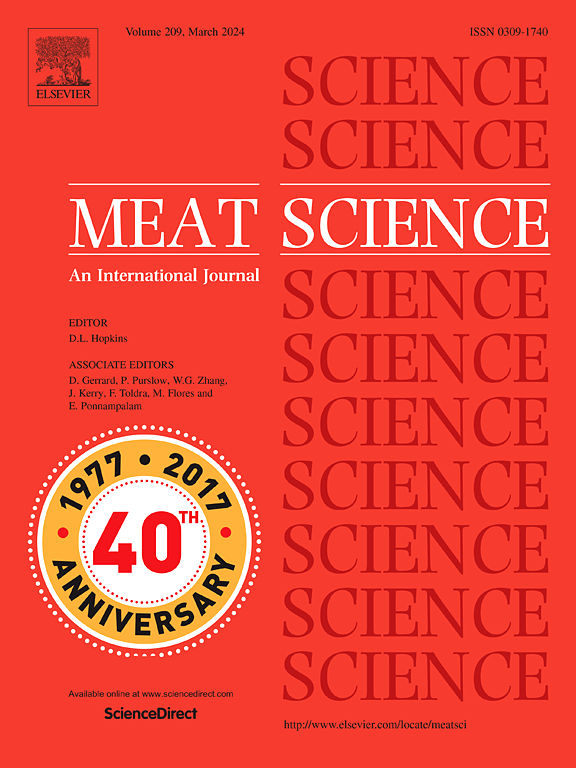饲粮混合添加巴巴苏油和葵花籽油对羔羊采食量、胴体性状和肉中脂肪酸组成的影响
IF 6.1
1区 农林科学
Q1 Agricultural and Biological Sciences
引用次数: 0
摘要
本试验旨在研究巴巴苏油(BO)和葵花籽油(SO)以不同比例混合对羊肉生产性能、品质和脂肪酸组成的影响。饲喂BO降低了干物质采食量(P = 0.019)、能量采食量(P = 0.029)、末重(P = 0.043)、屠宰率(P = 0.051)和皮下脂肪厚度(s.c. fat;P = 0.020),但不影响肉质性状。SO共混物的加入表现出二次效应(P <;0.05),但不影响胴体性状。饲粮BO日粮增加(P <;0.05)肉和s.c.脂肪中的反式单不饱和脂肪酸(trans-MUFA)。肉类中的饱和脂肪酸(SFA)和多不饱和脂肪酸(PUFA)没有变化。饲粮中添加SO混合物对反式mufa含量无显著影响(P = 0.810)。脂质补充不影响(P >;0.05),而BO降低了s.c.脂肪中PUFA的比例(P <;0.05)支链脂肪酸、顺式单不饱和脂肪酸(顺式- mufa)和18:0-氧。与单独添加豆油相比,饲粮中添加豆油混合物对生产性能和肉质性状没有广泛的影响。然而,添加18.6 g/kg的SO混合物增加了肉类中的顺式- mufa含量和s.c.脂肪中的BCFA含量,为已经利用这种脂质来源的当地亚马逊生产商提供了另一种选择。本文章由计算机程序翻译,如有差异,请以英文原文为准。
Impact of dietary Babassu oil and sunflower oil blend on feed intake, carcass traits, and fatty acid composition in meat of lambs
This study aimed to evaluate the effects of the blend of babassu oil (BO) and sunflower oil (SO) in different proportions on performance, quality, and fatty acid (FA) composition in lamb meat. Feeding BO reduced (P = 0.019) dry matter intake, energy intake (P = 0.029), final body weight (P = 0.043), dressing percentage (P = 0.051), and subcutaneous fat thickness (s.c. fat; P = 0.020) but did not change meat quality traits. The SO blend addition performed a quadratic effect (P < 0.05) on the nutrient intake, without affect carcass characteristics. Dietary BO diet increased (P < 0.05) trans-monounsaturated fatty acids (trans-MUFA) in meat and s.c. fat. However, saturated FA (SFA) and polyunsaturated FA (PUFA) in meat did not change. No difference in trans-MUFA content was found (P = 0.810) when adding SO blend to the diet. The lipid supplementation did not affect (P > 0.05) the PUFA proportion in s.c. fat, but BO reduced (P < 0.05) branched-chain fatty acids, cis-monounsaturated fatty acids (cis-MUFA), and 18:0-oxo compared to the unsupplemented diets. Dietary SO blend inclusion did not extensively modify productive and neither meat quality traits, compared to BO solely addition. However, the addition of 18.6 g/kg of SO blend increased cis-MUFA content in meat and BCFA in s.c. fat, representing an alternative for the local Amazon producers which already utilize this source of lipid.
求助全文
通过发布文献求助,成功后即可免费获取论文全文。
去求助
来源期刊

Meat Science
工程技术-食品科技
CiteScore
12.60
自引率
9.90%
发文量
282
审稿时长
60 days
期刊介绍:
The aim of Meat Science is to serve as a suitable platform for the dissemination of interdisciplinary and international knowledge on all factors influencing the properties of meat. While the journal primarily focuses on the flesh of mammals, contributions related to poultry will be considered if they enhance the overall understanding of the relationship between muscle nature and meat quality post mortem. Additionally, papers on large birds (e.g., emus, ostriches) as well as wild-captured mammals and crocodiles will be welcomed.
 求助内容:
求助内容: 应助结果提醒方式:
应助结果提醒方式:


